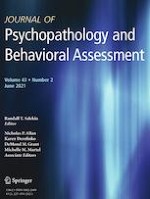10-11-2020
Unpacking Social Avoidance and Substance Use in Social Anxiety: Does Extraversion Explain Behavior Variability?
Gepubliceerd in: Journal of Psychopathology and Behavioral Assessment | Uitgave 2/2021
Log in om toegang te krijgenAbstract
Social anxiety is characterized by heightened fear and anxiety associated with social situations, resulting in the use of avoidance behaviors. Contemporary models suggest that some individuals with social anxiety may choose to completely avoid social situations, while others may seek social connections and interactions and utilize avoidance behaviors such as substance use as a means of distress tolerance, while engaging in these situations. Our aim is to test a theoretical model whereby extraversion could help to explain the heterogenous nature of social anxiety in relation to these behaviors. Lower levels of extraversion have been commonly associated with withdrawal behaviors and higher levels of extraversion have been associated with behaviors commonly enacted in social situations. Understanding factors which predict the use of one behavior over another is imperative to the conceptualization and successful treatment of patients with social anxiety. A sample of 195 college students completed self-report measures and a 10-day experience sampling diary with five diary signals each day. Participants were asked to rate their current negative emotions and behaviors during each diary signal. Using a multilevel modeling approach, we tested the association between social anxiety symptoms and negative affect predicting engagement in substance use or social avoidance and tested whether extraversion moderated this association. Negative affect was included as a covariate given the established associations between elevations in negative affect predicting both behaviors. Results indicated that higher levels of social anxiety symptoms and negative affectivity increased the probability of social avoidance and substance use, and extraversion was a significant predictor for only substance use. Moderation analysis indicated that extraversion moderated the relationship between social anxiety and substance use, suggesting a stronger positive relationship between substance use and social anxiety for individuals higher in extraversion. However, extraversion was not a significant moderator between social anxiety and social avoidance. Overall, the findings suggest that extraversion could be a key factor predicting the use of substances amongst individuals with social anxiety and may need further consideration in treatment.
